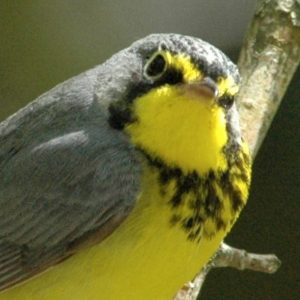Canada Warbler’s Steep Decline Prompts Recovery Planning from Scientists, Conservationists and Resource Managers
FOR IMMEDIATE RELEASE
MARCH 10, 2015
OTTAWA ON — Thirty scientists, conservationists and resource managers are coming together today in Ottawa to apply the best, most-recent science and problem-solving to halt the decline of the threatened Canada Warbler. Nature Canada is convening the workshop with the support of the Sustainable Forestry Initiative (SFI), Environment Canada, BirdLife International, Swarovski Optik and Weyerhaeuser.
Compared with the mid-1960s, today there is only one Canada Warbler where there were once three. This two-thirds population decline didn’t happen suddenly. On average, the population dropped by about 2.3% per year across North America between 1966 and 2013, according to the North American Breeding Bird Survey. This long-term decline won’t respond to short-term fixes.
“We are pleased that Nature Canada is convening this event and bringing us all together to focus on the Canada Warbler,” said Andrew de Vries, SFI Vice-President, Conservation and Indigenous Relations. “The SFI standard requires Program Participants to have programs in place for species at risk, so this workshop can help define what those programs may look like, and directly benefit the Canada Warbler.”
The Canada Warbler is a forest-dependent species, so it bodes well that both SFI and Weyerhaeuser, an SFI Program Participant and tenure holder in Canada Warbler breeding grounds, are among the partners supporting and participating in this workshop.
One of the great challenges in helping a species recover is determining the causes of its decline and then determining what can be done to stabilize the population. Is the problem in the breeding grounds, in the wintering grounds or along its migration route around the Gulf of Mexico and the Caribbean through Central America? Are there one or several factors behind the decline such as changing weather patterns, food scarcity or suitable habitats?
Although more than 80% of its breeding range is in Canada, the Canada Warbler also breeds in the Appalachians of the eastern United States. Canada Warblers migrate to the forested slopes of the Andes Mountains in Colombia, Ecuador, Peru and Venezuela, where they stay from October to April.
“We know that many issues are likely affecting the Canada Warbler in its breeding grounds. At the end of this workshop, we will know better what we must do to help this species. We also expect that in helping the Canada Warbler, we will be able to help many other species that share the same habitats,” said Ted Cheskey, Senior Conservation Manager, Nature Canada.
This workshop is part of the Canada Warbler International Conservation Initiative. Participants will be coming from across Canada and the eastern United States.
-30-
About Sustainable Forestry Initiative® Inc. (SFI)
SFI® Inc. is an independent, nonprofit organization that is solely responsible for maintaining, overseeing and improving the internationally recognized SFI program. Across the United States and Canada, more than a 100 million hectares are certified to the SFI Forest Management Standard. In addition, the SFI Fiber Sourcing Standard directs how SFI Program Participants procure fiber from non-certified land, encouraging the use of responsible forestry practices. SFI Chain-of-Custody Standard tracks the percentage of fiber from certified forests, certified sourcing and recycled content through production and manufacturing to the end product. SFI on-product labels help consumers make responsible purchasing decisions. SFI Inc. is governed by a three-chamber board of directors representing environmental, social and economic sectors equally. Learn more at sfiprogram.org and sfiprogram.org/Buy-SFI.
About Nature Canada
Nature Canada is the oldest national nature conservation charity in Canada. Over the past 75 years, Nature Canada has helped protect over 63 million acres of parks and wildlife areas in Canada and countless species that depend on this habitat. Today, Nature Canada represents a network of more than 45,000 members and supporters and more than 350 nature organizations across the country, with affiliates in every province. Nature Canada focuses on effecting change on issues of national significance including bird conservation, citizen science initiatives, urban nature initiatives, building a national network of conservation organizations, building a network of volunteers to care for critical natural habitat sites across Canada and being a voice for nature at the federal level.
Media Contacts
Elizabeth Woodworth
Vice President, Communications and Community Engagement
Sustainable Forestry Initiative Inc.
Tel: 202-596-3452
media@sfiprogram.org
Ted Cheskey
Senior Conservation Manager
Nature Canada
Tel: 613-562-3447 ext. 227
tcheskey@naturecanada.ca


